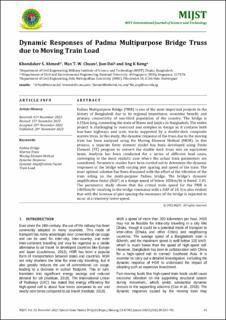Dynamic Responses of Padma Multipurpose Bridge Truss due to Moving Train Load
Original version
MIST International Journal of Science and Technology. 2022, 10 65-78. https://doi.org/10.47981/j.mijst.10(02)2022.383(65-78)Abstract
Padma Multipurpose Bridge (PMB) is one of the most important projects in the history of Bangladesh due to its regional importance, economic benefit, and primary connectivity of one-third population of the country. The bridge is 6.15km long, connecting the ends of Mawa and Janjira in Bangladesh. The entire project is challenging to construct and complex in design as it contains both four-lane highways and train tracks supported by a double-deck composite warren truss. In this study, the dynamic response of the truss due to the moving train has been analyzed using the Moving Element Method (MEM). In this process, a separate finite element model has been developed using Finite Element (FE) program to convert the double deck truss into an equivalent beam. Analysis has been conducted for a series of different load cases, converging to the most realistic case where the actual train parameters are considered. Parametric studies have been carried out to determine the dynamic responses of the bridge with varying pier spacing and speed of the train. The most optimal solution has been discussed with the effect of the vibration of the train acting on the multi-purpose Padma bridge. The bridge's dynamic amplification factor (DAF) at a design speed of below 100km/hr is found 1.05. The parametric study shows that the critical train speed for the PMB is 1400km/hr resulting in the bridge resonance with a DAF of 18. It is also evident that with the increase of pier spacing the resonance of the bridge is expected to occur at a relatively lower speed.

